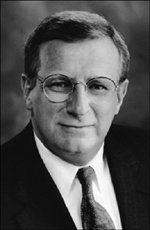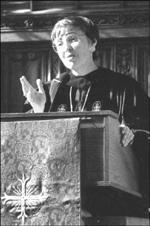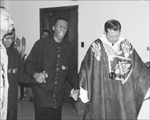When her visitor shook her head in wonderment at experiencing back-to-back worship in a Presbyterian church where the choir sang in Latin and a Roman Catholic church where the mass included an altar call, Sandra Evans, director of the African American Ministries Program at McCormick Theological Seminary, just nodded sagely. “That’s Chicago,” she said.
McCormick Theological Seminary has been in Chicago for 140 years and has forged lasting ties with lots of Presbyterian congregations in and around the city. As Cynthia McCall Campbell, president of the school for the last five years, points out, “We count on congregations to send students. We count on them to support us financially. And we count on them to help our students fulfill their requirement of practice of ministry skills.”
McCormick’s makeup has changed over the years. Now almost half of the school’s students belong to denominations other than Presbyterian. This has called for a new attentiveness to congregational life in the city and made for some alliances that McCormick’s founders could not have imagined.
 |
| The Reverend John Buchanan, pastor of Chicago’s Fourth Presbyterian Church, preaches a gospel of welcome and inclusiveness. |
Old Ties
At precisely 9:30 on Sunday morning at Fourth Presbyterian Church, the harpist concludes her prelude, the choir files into its loft in the front of the sanctuary, and worship begins. It concludes, as the bulletin board on Michigan Avenue promises, fifty-five to sixty minutes later. In the meantime, the choir sings several times—twice in Latin, with English translation provided in the twelve-page worship program and guide to church activities. Scripture is read, hymns are sung, prayers are offered. The center of the service, though—cued by the dimming of lights in the nave and increased illumination of the elevated pulpit—is pastor John Buchanan’s sermon. It is classic liberal Protestant preaching at its measured best. Buchanan begins with comment on a civil rights sit-in anniversary, moves smoothly to Jesus’s lunch with a tax collector, and, with side allusions to Anne Lamott, the best-selling spiritual writer, and to the cultural anthropology of food, brings us to the table, which he calls the church’s “most precious symbol,” a place where unlikely combinations of people sit down to share.
It is a plea for a welcoming church, and Fourth Church tries. During “concerns of the church,” visitors are encouraged to put on the metal badge from their pew card whose text begins, “We are delighted that you have been chosen to worship at the Fourth Presbyterian Church of Chicago.” There are small groups for professional women with children, for gay and lesbian church members, for opera aficionados. Special events for March include a lecture by Harvard’s Peter Gomes. Service projects abound. For all that, the congregation is very white and clearly pretty prosperous. The church’s location on the Magnificent Mile is a factor, of course. Worship attendance doesn’t come cheap; parking options start at $4.75 with church validation.
Fourth Church’s history of close involvement with McCormick Theological Seminary dates back to the 1800s. At one time Fourth Church pastors routinely held adjunct faculty status; one pastor moved from Fourth Church to the presidency of the school. Buchanan is vice chair of McCormick’s board. When asked whether board appointment came with his Fourth Church position, he replied, “The first term did, I think.” (Buchanan, who has been at Fourth for fifteen years and is also editor and publisher of the Christian Century, is in his second term.) Although Buchanan is not a graduate of McCormick—he went to the University of Chicago Divinity School—several of Fourth’s associate pastors are. A number of McCormick faculty members consider Fourth their home church. Three or four students at a time routinely do internships in the church’s outreach programs.
 |
| The presence of McCormick’s President Cynthia Campbell in Chicago pulpits (in this case, Fourth Presbyterian’s) strengthens the bonds between the seminary and neighbor congregations. |
Becky Chamberlain is one such, although she is no longer a student. She began working at Fourth last year during her final year of studies. She continues in a temporary position while she seeks a call to a Presbyterian church. Her job, in part, is expanding the congregation’s sense of global mission—with a study trip to Northern Ireland planned for this summer and a plan to have disaster relief teams trained and ready to travel from the church.
She also works with the “advocates for justice” committee, which has petition signature drives at coffee hour when relevant legislation is pending. She has helped increase committee involvement in decisions about funding local service agencies by developing a standardized application for funds and making committee members responsible for reading and presenting them. “Fourth Church is in a unique situation,” she said. “The Gold Coast and Cabrini Green are both part of our neighborhood.” She acknowledges that the Gold Coast is more in evidence at worship. She has her own sense of the tension between a desire to make the church a welcoming place and a desire to protect the sensibilities of those who are new to diversity. “We have a Sunday night supper that sixty to eighty neighborhood people attend,” she explained. “I’ve gotten to be on a first-name basis with most all of them, and they notice when I’m not there. But sometimes I look around and think, ‘Are these the sort of people I would have been comfortable with a few years ago?’ And, of course, the answer is no.”
Chamberlain hopes to do ministry in a multiple-staff urban or suburban parish, and she realizes that McCormick’s strength in urban ministry has attracted her—a solidly Presbyterian European American—for the same reasons it has attracted growing numbers of people ethnically and denominationally unlike her. She’s grateful for the cross-fertilization, she said.
President Campbell’s is a familiar face at Fourth. She often worships there when she has no other Sunday obligations, and Buchanan does not hesitate to ask her to preach when he is away. “She was a pastor in Salina, Kansas, before she went to teach at Austin [Presbyterian Theological Seminary],” he points out, “and she has a parish touch.”
Campbell reaches out to touch a fair few parishes, as do the rest of the faculty at McCormick, most of whom make themselves available to preach and teach in congregations. “I’m not certain that every single faculty member goes out,” she said, “but most have a real knack for communicating in settings beyond the traditional classroom.”
The professors are cementing old ties on some visits, but they’re also on the lookout for congregations that might be lively partners for the school. McCormick has 450 students, all of whom will need at least one field education site. Almost half of the students these days are African Americans—almost none of these are Presbyterian. (Many come through the school’s African American Leadership Partnership Program, which forms cohort groups of students who take courses together while working toward their master of arts in theological studies or doctor of ministry degrees.) McCormick has, of necessity, formed partnerships with an array of congregations across the theological spectrum.
 |
|
Randall Blakey, a McCormick student and St. Sabina’s Church lay leader, prays before mass with the church’s pastor, the Reverend Michael Pfleger.
|
New Connections
It’s 11:45, and although mass time is advertised as 11:15, things are just warming up at St. Sabina’s on Seventy-eighth Place. A gospel choir works the crowd that, while primarily African American, includes a broad range of hues. A matriarch in a lime-green suit and white gloves sits next to a confused woman with duct tape matted into her hair (and who breaks into a dance of sheer joy upon receiving communion). She sits next to a young couple with three little girls in braids. The invocation is offered at around noon, and things don’t break up until three. All the elements of the mass are part of the mix, along with a great deal of singing, which always involves the congregation. The sermon is central here, too—pastor Michael Pfleger (European American, by the way) speaks about the primacy of the believer’s relationship with Jesus—and draws it out in highly personal fashion. “Some of you need to do some housecleaning this afternoon,” he says, suggesting that people with live-in lovers show them the door. At the conclusion of the sermon, which the congregation follows with focused and vocal attention, he offers an altar call, and people walking the aisle are supported with applause.
Randall Blakey is director of ministries at St. Sabina’s—and a student at McCormick. Blakey covered events at the church (including a campaign to eliminate tobacco and alcohol ads from neighborhood billboards) when he worked for the local CBS affiliate, and thereby gained enough trust to talk to the pastor when spiritual issues came to the fore in his life. He joined St. Sabina’s, became chair of the parish council and leader of a group called the armor bearers, who gather to pray for the pastor. Eventually he realized that, in his words, “the Lord was dealing with me about knowledge.” About this time, a McCormick student spoke to the congregation’s men’s group, which helped focus Blakey’s interest in theological study. He asked his pastor for counsel, and Pfleger suggested, correctly, that McCormick might be a good fit. “I can’t say enough about the school,” said Blakey.
It’s OK to Be Here
How does a congregation like St. Sabina’s become an ally of a school like McCormick? Through networking in the African American religious community and, thereby, in part through the work of Sandra Edwards. When she came to McCormick in 1996 to head the African American Ministries Program, her first order of business was making connections with congregations. She began with a series of 100 clergy interviews. “I learned right away that the busiest pastors made time for me right away, and they’ve been the most helpful.” Among the interviewees was Pfleger. “Our relationship with McCormick is a matter of sharing mutual experiences with churches that are about the gospel,” he said, “We need—and have—open doors on both sides. After all, part of theological education is exposing students to a whole lot.” The school and the congregation have cooperated in putting on Christian education programs for adolescents. Speakers from the school have addressed the church and vice versa—and Blakey is nearing graduation.
Other congregations have similar stories. Campbell notes that a comfort level between school and congregation leads to word of mouth that, in turn, leads to more students. Trinity United Church of Christ, an African-American congregation, has sent no fewer than ten students to McCormick. (She also tells of a visit to Trinity by a group of pastors from Korea who are enrolled in McCormick’s D.Min. program. They were welcomed and sang “His Eye is On the Sparrow” in Korean—whereupon the choir rose spontaneously and backed them.) “Students tell potential students, ‘It’s OK to be here,’” she said.
 |
| Sandra Edwards builds bridges to new ministry opportunities for students. |
Edwards teaches courses in Presbyterian polity and other courses in ministry, but her job also involves honoring connections. She interacts with the school’s Hispanic ministries and Korean American ministries programs, with the African American Leadership Partnership Program, and with the Urban Ministry Program. She spends time with congregations of various denominations. Her desk is littered with programs from prayer breakfasts, women’s conferences, and the like. She keeps in touch with the other local theological schools (eleven in the Chicago area), trying to cut down course overlap. Twice a year she hosts local clergy as they meet with seminary administrators and talk about what programs might be helpful to their ministries. The work is paying off. McCormick is respected in a circle far wider than its historical base.
Presbyterian After All
Although McCormick, like most denominational theological schools these days, enrolls students from a broad range of other denominations, the majority are Presbyterians. Campbell has taken the time to think out the relevance of the sponsoring denomination in the midst of increasing diversity.
“Being a seminary of the Presbyterian Church,” she said, “is a continuing commitment to the Reformed tradition. This manifests itself in the work of theological education itself: critical interpretation of scripture; excellence in scholarship; openness to the ways in which other disciplines (humanities, social sciences, hard sciences) contribute to our understanding of humanity and God; a commitment to preparing people for ministry in the church engaged with the world (our urban ministry and emphasis on social transformation is part of that heritage); and, finally, being ecumenical—both in what we teach and how we teach it.”
A Tale of Two Cities
One facet of McCormick Theological Seminary’s outreach to churches in the city is its Urban Ministry E-Journal, available on line at www.mccormick.edu/urban. In this piece, excerpted from the journal, McCormick student Leanne Price reflects on the Chicago she knows and the promised New Jerusalem.
While biking along the lake, I may stop in wonder to gaze at the gleaming city skyline ahead of me, until I begin coughing from an unexpected lungful of car exhaust. I stand on the beach to admire the sun rising over the lake, then look at my feet to see old cans and plastic cups washing up to the shore. In the playground at Ray School, kids of every color run and play together with shrieks of laughter. In other neighborhoods, I am told, crossing an invisible border invites violence if you are the “wrong” race. Downtown museum-goers experience the wonder of the arts from all over the world, while outside the museum folks beg for change for dinner. Flowers bloom next to the freeway. There is beauty and life and kindness in the city that cannot be suppressed, and they seem all the more extraordinary, set as they are, against a backdrop of dirt and pain and violence. For those of us who look beyond the ugliness, it is Real.
I have faith that the city is also Real to God. And yet, in Revelation, John presents an idealized vision of God’s transformation of the New Jerusalem, a vision that has little in common with the reality of good and evil intertwined that we know as the city. At first glance, the New Jerusalem sounds nothing like the Real city that I know and love, or even a city that I would especially like to inhabit. With its jeweled walls and streets paved with gold, it seems more like a shiny wind-up toy that has to be carefully kept than a candidate for becoming Real. However, a closer reading of John’s description of the New Jerusalem reveals God’s vision of the city as a radically egalitarian community marked by God’s all-encompassing presence. It is a transformation that will make the city Real to everyone.
Clearly God’s vision for the city as expressed in John’s description of the New Jerusalem is quite different from the city we know and love. The shared wealth of the New Jerusalem stands in sharp contrast to the extreme economic disparity that marks modern cities, where everything of value is carefully locked up or bolted down. Political power, made subject to God in the New Jerusalem, here is used for personal gain and advancement. In our city, we see churches that welcome some and turn others away. The city seems a far cry from the Kingdom of God. And yet, among the many signs of the “Anti-Kingdom,” some of us are able to find glimpses of the Kingdom of God right here among us. We live in the tension between the signs of the Anti-Kingdom and these precious glimpses of God’s Kingdom.
Accordingly, our task in urban ministry is twofold. First, we must help others imagine God’s vision for the city and discover how Christ has already initiated that vision in our midst. Jesus said, “The Kingdom of God is not coming with things that can be observed; nor will they say, ‘Look, here it is!’ or ‘There it is!’ For, in fact, the Kingdom of God is among you.” (Luke 17:20-21) We don't have to wait for the pearly gates and streets of gold of the New Jerusalem, for the Kingdom is here! But for God's people living in the city, that Kingdom can be difficult to find. Those ministering in the city must speak prophetically, naming and proclaiming God's presence among us. Second, in urban ministry we must recognize that God's transformation of the city is not yet complete, and work to transform those signs of the Anti-Kingdom into God's vision for the city.